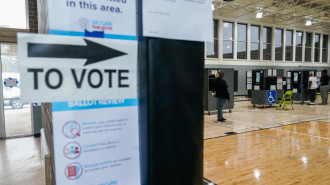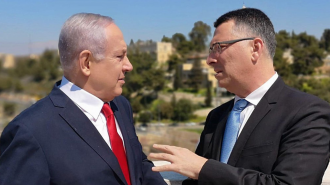Magnitude 4.5 earthquake hits near Iran's only nuclear plant
The quake, which had a depth of 10 kilometres, struck 17 kilometres south-southeast of Borazjan city at 6:49 am (0319 GMT), the US Geological Survey said on its website.
State news agency IRNA said the earthquake was felt in Bushehr, the site of the country's sole nuclear power plant.
So far, there were no reports of any deaths or damage, IRNA said, citing Jahangir Dehghani, the head of Bushehr's crisis management centre.
In-depth: How drinking water has become a major conflict deterrence factor in the Gulf region
US security analysis blog Strategic Sentinel tweeted that the depth and epicentre of the quake "indicate it was a natural event and unrelated to this [evening's] events," referring to an Iranian strike on a US air base Iraq and the fatal plane crash in Tehran.
The latest quake comes exactly a fortnight after a magnitude 5.1 earthquake hit the same area, without causing any casualties or major damage.
The Bushehr plant, which produces 1,000 megawatts of power, was completed by Russia after years of delay and officially handed over in September 2013.
In 2016, Russian and Iranian firms began building two additional 1,000-megawatt reactors at Bushehr. Their construction was expected to take 10 years.
Twitter Post
|
Gulf Arab concerns
Iran's Gulf Arab neighbours have often raised concerns about the reliability of the Bushehr facility and the risk of radioactive leaks in case of a major earthquake.
The Islamic republic is seeking to reduce its reliance on oil and gas with 20 nuclear power plants planned over the coming years.
Its nuclear programme is at the centre of a dispute with the United States, which suspects Iran is trying to obtain a nuclear weapons capability, something the Islamic republic vehemently denies.
Tensions have escalated since May last year when US President Donald Trump withdrew from a landmark 2015 accord.
The Joint Comprehensive Plan of Action, or JCPOA, gave Iran relief from sanctions in return for curbs on its nuclear programme.
Iran sits on top of major tectonic plates and sees frequent seismic activity.
In November 2017, a 7.3-magnitude quake in the western province of Kermanshah killed 620 people.
In 2003, a 6.6-magnitude quake in southeastern Iran decimated the ancient mud-brick city of Bam and killed at least 31,000 people.
Iran's deadliest quake was a 7.4-magnitude tremor in 1990 that killed 40,000 people in northern Iran, injured 300,000 and left half a million homeless.
Follow us on Twitter and Instagram to stay connected

![Palestinians mourned the victims of an Israeli strike on Deir al-Balah [Getty]](/sites/default/files/styles/image_684x385/public/2024-11/GettyImages-2182362043.jpg?h=199d8c1f&itok=xSHZFbmc)


![The law could be enforced against teachers without prior notice [Getty]](/sites/default/files/styles/image_684x385/public/2178740715.jpeg?h=a5f2f23a&itok=hnqrCS4x)
 Follow the Middle East's top stories in English at The New Arab on Google News
Follow the Middle East's top stories in English at The New Arab on Google News

![Palestinian journalists in West Bank [Getty]](/sites/default/files/styles/image_330x185/public/2167088057.jpeg?h=a5f2f23a&itok=smdkN-46)
